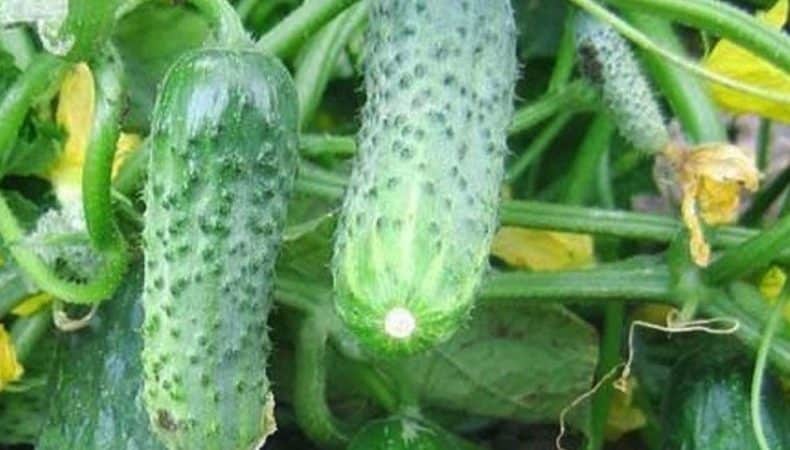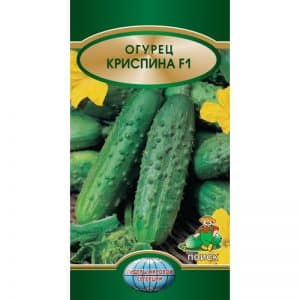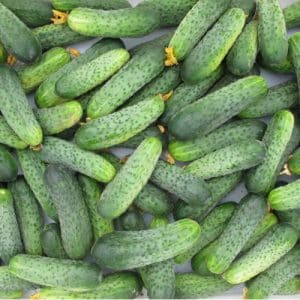Unpretentious, productive and tasty cucumber “Crispina” from Dutch breeders
One of the most popular vegetable crops grown in gardens is cucumber. Of all the variety of crops, the Crispin hybrid stands out, winning the hearts of a large number of gardeners with its ease of care and abundant harvest.
From the article you will learn how to grow this hybrid in your summer cottage, what its yield is, its advantages and disadvantages.
Description of cucumbers
This plant was bred by biologists from Holland. When creating it, the goal was to develop a hybrid suitable for growing in a greenhouse, hotbed and open ground. The Crispin f1 hybrid was included in the register of the Russian Federation in 2000 and is approved for cultivation in any region of Russia.
Distinctive features

The hybrid is a parthenocarpic species, that is, it does not need the help of insects for pollination. When compared with other hybrids and varieties, Crispina does not require a large amount of heat at the initial stage of fruit ripening and is more resistant to high temperatures during the growing season.
Composition, properties, benefits, calorie content
The fruits of the plant contain a lot of useful microelements - vitamins B1 and B5, carotene, calcium, sodium, potassium, phosphorus, folic acid and chromium, as well as structured water.
Cucumbers are low in calories, help remove toxins from the body, stimulate digestion and help fight excess weight. Per 100 g there are from 10 to 15 kcal.
Characteristics

The hybrid is mid-season, has small-sized fruits of the same shape, in the form of a long cylinder with tubercles. The fruits reach 13 cm in length and up to 5 cm in diameter. On average, the weight of the fruit is 100 g. Externally, cucumbers are distinguished by their dark green color and light stripes. The fruits have a long shelf life and can be transported over long distances.
The bush grows to medium size and has powerful roots. A small number of leaves are bright green and small in size. Many stepsons can form on the trunk of a plant.
Up to 5 fruits are formed on one node. The first cucumbers can ripen 50 days after planting. The hybrid is valued for its high yield, which reaches up to 10 kg per 1 m². The fruits have aromatic and crispy pulp without bitterness.
How to grow your own
The hybrid is suitable for growing in open ground and in greenhouses. For planting, you can use seedlings to obtain earlier fruits or sow the seeds directly into open ground. Regardless of the chosen method, growing Crispin always gives excellent results.
Planting by seeds and seedlings
The process of planting seeds in a greenhouse or open ground is carried out in several stages. They start by selecting seeds with optimal performance. It is important to ensure that the seeds prepared for planting are not damaged. Using small seeds will not bring good results.
Before planting, it is necessary to soak the seeds in water. To do this, they are immersed in a salty water solution for 10-15 minutes. To prepare the solution you will need 50 g of salt per 1 liter of liquid. After this, you need to calibrate the seeds and select only large and full-bodied ones.
The selected planting material must be warmed up. To do this, they are placed in a gauze bag in a thermos containing water, the temperature of which does not exceed 50 ° C, and kept for 2 hours. To disinfect, seeds are dipped in a solution of potassium permanganate for half an hour. After completing this procedure, the seeds are washed using running water.
Attention! Hybrid seeds are often disinfected and treated with nutrient solutions in the factory. This material has a bright color. There is no need to prepare it additionally.
It is recommended to plant seeds in nutritious soil, and seedlings in peat pots.
If the seedlings will be grown in ordinary containers, you will need prepared soil. To prepare it, peat, humus and turf soil are mixed. Be sure to add superphosphate.
If planting will take place directly into the ground without growing seedlings, you need to form beds in advance. Parallel to the rows where the cucumbers will grow, additional rows are formed and filled with manure and minerals. fertilizers. This procedure guarantees full and accelerated development of plants.
Reference! If cucumbers are grown using seedlings, then 25 days after the sprouts appear, they are transplanted into the ground.
Cucumbers are planted keeping a distance of 45 cm between bushes. The soil temperature for planting should be 15-20 °C, and the air temperature should be at least 15 °C. Cucumbers are planted in open ground towards the end of May or beginning of June.
This plant loves sunlight, so when choosing a place to plant, consider the illumination of the area. It is equally important to protect the cucumbers from the wind.
The optimal temperature for the development of bushes is not lower than 22 °C.The hybrid tolerates slight temperature fluctuations well, but if there are severe frosts, the plant will die. To avoid freezing at the initial stage, cover the plant at night.
It is important to choose the right predecessors for Crispin's cucumbers. Ideal conditions are in areas where legumes, cabbage, green manure or corn previously grew. The yield will be lower if you plant cucumbers after beets or zucchini, since they have already taken the nutrients that cucumbers require from the soil.
Growing in stages and care
The harvest directly depends on the care of the plant. The following stages of caring for the Crispin hybrid are distinguished:
- Watering. Cucumber needs regular moisture. Watering is important throughout the life of the plant. It is important to water with warm water, otherwise there is a risk of rot. Lack of moisture inevitably leads to the appearance of a bitter taste in the fruit. Since frequent watering will cause the soil to become denser, it is necessary to loosen the soil. The procedure is carried out carefully so as not to damage the roots of the plant.
- Fertilizer. For feeding, chicken droppings or manure, mineral mixtures (solutions of calcium or potassium nitrate) are used. Fertilizing is carried out no more often than once every 2 weeks.
- Stepsoning. If the plant is grown in a greenhouse, to increase productivity, the bush is formed into 1 stem with stepsons on the side.
- Defence from pests And diseases. Treatment is carried out until fruit formation, once every 2 weeks. If you need to process the plants when the fruits are already formed, you must first collect all the fruits. After treatment, you can harvest after 3 days.
Features of cultivation and possible difficulties
The hybrid is easy to grow.The process of growing Crispin cucumbers is practically no different from other hybrids and does not cause difficulties.
Diseases and pests
The hybrid is characterized by high immunity, resistant to cladosporiosis, powdery mildew and common mosaic.
However, you still need to monitor the condition of the plant so that when the first signs of the disease appear, immediately treat it with folk remedies or medications.
Harvesting and application

The harvest is harvested in mid-summer, no later than the end of July. It is important to collect fruits from the bush in a timely manner: this will make the harvest more abundant. Over-ripening should not be allowed - it is recommended to collect fruits every 48 hours, preferably in the morning, before the onset of the day's heat, or in the afternoon, after the temperature has subsided.
Crispina fruits are suitable for use in any form. Can be consumed fresh or preserve for the winter. The excellent taste of the fruit will remain regardless of the type of use.
Advantages and disadvantages
Key benefits of Crispin's cucumbers:
- long fruiting period;
- long shelf life, the taste of the fruit is not lost;
- early ripening;
- ease of cultivation and subsequent care;
- beautiful fruit shape;
- unpretentiousness in transportation.
The only negative that gardeners pay attention to is the bitterness that appears if there was a problem with the supply of moisture.
Reviews
There are only good reviews about this hybrid. All gardeners agree that growing cucumbers is as simple as possible; even a novice gardener does not have any problems.
Elena, Novgorod: “I purchased a hybrid on the advice of neighbors. The fruits look like gherkins and are good for pickling. The hybrid turned out to be unpretentious in cultivation.I decided that I would definitely use it in the next seasons.”
Lyudmila, Kislovodsk: “I really liked this hybrid. The grandchildren love to eat crispy cucumbers. The bushes withstood frost and hot weather without problems. I was pleased with the long shelf life in a cool place.”
Conclusion
The Crispin hybrid does not require much effort when growing - just following basic care measures is enough. The culture is characterized by unpretentiousness to climatic conditions, high productivity, and excellent taste of the fruit.